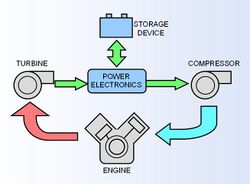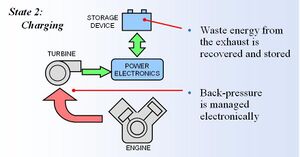Engineering:Hybrid turbocharger
A hybrid turbocharger is an electric turbocharger consisting of a high speed turbine-generator and a high speed electric air compressor. The turbine and compressor are high-speed aeromachines, as in a conventional turbocharger. The electrical motors run at speeds in excess of 120,000 rpm and when used as generators, generate electricity at up to 98.5% electrical efficiency. High electrical efficiency is paramount, because there is no mechanical link between the turbine and compressor. In other words, hybrid turbocharger refers to a series hybrid setup, in which compressor speed and power are independent from turbine speed and power. This design flexibility leads to further improvements in turbine and compressor efficiency, beyond a conventional turbocharger.
Physical arrangement
The electric motors utilize permanent magnets which have a higher efficiency than standard high speed induction motors. Induction motors induce an electro-magnetic field into a solid rotor core.
Operating modes
Acceleration
When the driver depresses the throttle, the HTT initially acts like an electric supercharger. The compressor motor is powered from the energy storage medium allowing it to accelerate to full operating speed in <500 ms. This rate of acceleration eliminates the turbo lag which is a major limiting factor on the performance of standard turbocharged engines.
During this transient stage, the engine control unit (ECU) on a standard turbocharged engine uses a combination of sensors such as lambda sensors and air mass flow sensors to regulate the fuel flow rate. In an HTT equipped engine the ECU can deliver the precise fuel flow rate for complete combustion more accurately. This is achieved by directly controlling the air flow rate and boost pressure via control of the compressor speed.
Charging
At high engine speeds there is more energy generated by the turbine than is required by the compressor. Under these conditions, the excess energy can be used to recharge the energy storage for the next acceleration phase or used to power some of the auxiliary loads such as an electric air conditioning system.
When combined with a variable geometry turbine, the back pressure on the engine can be varied according to the electrical demands of the vehicle and charge state of the energy storage medium.
Development is underway for replacing battery energy storage with a super capacitor which can be charged and discharged very quickly.
Steady state
For the majority of the time the hybrid turbocharger is operating, the compressor and turbine power (not necessarily speed) will be matched. This gives an extra degree of freedom to the designer of a turbocharger impeller.
Here the hybrid turbocharger efficiently transfers the electricity between the turbine and compressor. Aeristech's latest test program has proven the efficiency of the hybrid turbocharger to be equivalent to (if not better than) that of an ordinary mechanical turbocharger.
System benefits
Some manufacturers claim many other benefits to running a hybrid turbocharged engine:
- Improved packaging by enabling the turbine and compressor to be placed in separate parts of the engine bay.
- Higher density charge air by reducing the length of intake ducts and increasing the size of the compressor wheel.
- ECU controlled boost levels will enable tighter predictive control of in-cylinder combustion.
- Similar engine downsizing benefits to a hybrid vehicle, but with far less (approx 1/7th) energy storage capacity to achieve the same level of downsizing.
Other types of electric turbochargers and electric superchargers are under development:
- eBooster by BorgWarner - a small auxiliary electric compressor powered by the vehicle's electric system.
- TurboPac by TurboDyne - Electric supercharger
- Garrett electrically-assisted turbo
- Valeo - Electric supercharger using a low-inertia switched-reluctance motor
Decoupled Gas Turbine Generator
This is a similar technology but applied to micro gas-turbine engines. Here they use an electrically coupled compressor and turbine in an engine directly and not to assist a piston engine.
The engine compresses the fuel to be burned in a combustion chamber which is ejected via the turbine.
Its claimed this engine overcomes the inefficiencies in small scale gas-turbine engines.
Usage in motorsport
Formula One
Sports car endurance racing
References
- Calnetix Hybrid Turbocharger Case Study
- Aeristech Ltd Hybrid Turbocharger Technology
- AutoSpeed Turbo Revolution - The Coming Technologies
- TurboDyne
de:Motoraufladung es:Sobrealimentador id:Supercharger it:Compressore volumetrico





